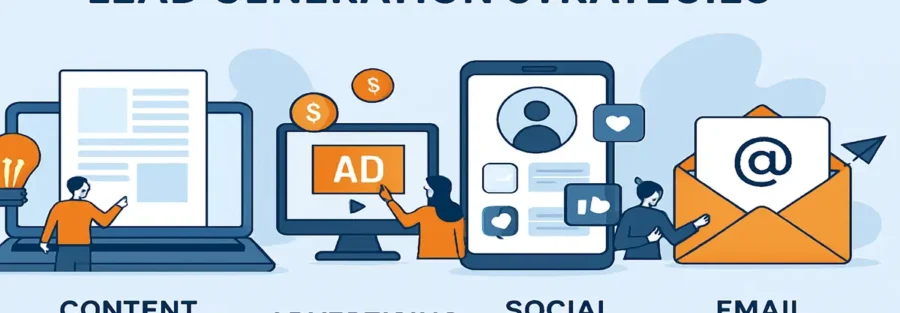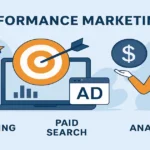Introduction:
Have you been investing time and money in marketing, only to end up with disappointing results? Are you finding that your website visitors are not turning into leads, or your leads are not turning into paying clients? Then you’re not alone. Most companies, whether startups or enterprises, struggle to find and implement effective lead generation tactics.
With the age of the digital world, competition is tough, and attention spans are short. This is why it is now more crucial than ever to leverage lead generation tactics that work. You might be a small business owner, a marketer, or a sales professional, but learning to attract, engage, and convert prospects into leads is the key to business success.
This blog will take you through everything there is to know about lead generation strategies: what they are, why they are important, their key characteristics, real-world case studies, actionable steps on how to implement them, and FAQs. By the end of it, you’ll have a clear guide to increase conversions and propel your business.
What are Lead Generation Strategies?
Lead generation tactics are the techniques and strategies that companies employ to entice prospective customers and turn them into leads—individuals who have expressed interest in your service or product. They are meant to take prospects through the early stages of the buyer’s process.
The fundamental principle of lead generation tactics is this: provide value to create interest. This may be by posting an eBook for free, providing a webinar, hosting a contest, or optimizing landing pages for leads. When an individual completes a form or subscribes, they are considered a lead.
There are two broad categories of lead generation tactics:
- Inbound Lead Generation – Aims to draw leads using content marketing, search engine optimization, social media, and offerings of value.
- Outbound Lead Generation – A method that involves contacting prospects using cold emailing, sponsored advertisements, telemarketing, and direct mail.
The best plans usually blend the two strategies in order to generate maximum results. The objective isn’t to produce any leads but to produce qualified leads—the ones most likely to become customers.
The most important aspects of effective lead generation strategies are:
- Knowing your audience
- Developing strong offers
- Building high-conversion landing pages
- Lead nurturing via email
- Tracking and optimizing campaigns regularly
In conclusion, lead generation strategies form the base of customer acquisition and sustainable business growth.
Why Lead Generation Strategies Matter
Without leads, there are no sales. Without sales, there is no revenue. It’s as simple as that. But let’s look deeper into why lead generation strategies are so important for businesses today.
- Fuel Business Growth: Leads are the lifeblood of any business. Successful lead generation strategies provide a consistent flow of potential customers, which keeps your sales pipeline full.
- Improve ROI on Marketing: By reaching the right audience with the right message, you eliminate waste and boost return on investment.
- Build Brand Awareness: With every lead you create, you drive up exposure. Over time, your brand is more recognizable, more trustworthy, and top-of-mind.
- Enable Customer Insights: With lead generation, you collect valuable information about your audience—what they desire, what they react to, and how they act. This informs the way you enhance products and marketing initiatives.
- Build a Predictable Revenue Model: With lead generation strategies executed correctly, you build a reliable pipeline, enabling you to make more accurate revenue projections and grow with confidence.
- Increase Sales Efficiency: With more qualified leads, your salesforce can spend more time closing the deal and less time pursuing uninterested leads.
Ultimately, lead generation strategies enable marketing and sales alignment, leading to a smooth journey from visitor to paying customer. In a time when customer acquisition costs are increasing, a sophisticated strategy provides you with a competitive advantage.
Key Features of Effective Lead Generation Strategies
To build lead generation strategies that truly convert, some features are required. These are the blocks that separate successful campaigns from subpar ones.
- Targeted Content: Content should tackle specific pain points of your audience. This may include blogs, whitepapers, videos, or infographics specific to every step of the buyer’s journey.
- Engaging Call-to-Actions (CTAs): CTAs lead users to the next step. Good CTAs should be clear, action-oriented, and consistent with the value you are providing.
- Optimized Landing Pages: Your campaign can be made or broken by a well-designed landing page. It must have a compelling headline, convincing copy, and an easy form.
- Multi-Channel Integration: Successful strategies employ multiple channels—email, social media, search engines, and even offline methods—to engage prospects wherever they may be.
- Marketing Automation: Software such as HubSpot, Mailchimp, or ActiveCampaign can automate follow-ups and lead nurturing, enhancing efficiency and customization.
- Analytics and Testing: A/B testing, conversion tracking, and performance analysis enable you to know what works and optimize results repeatedly.
- Lead Scoring and Segmentation: All leads are not created equal. Scoring leads on their behavior and profile facilitates targeting and conversion.
- Trust Signals: Testimonials, reviews, certifications, and case studies establish credibility and drive conversions.
These features combined create a system that attracts, nurtures, and converts leads successfully.
Case Studies: Real Results from Real Strategies
- HubSpot’s Inbound Success: HubSpot utilized content marketing as the basis of its lead generation. They published hundreds of informational blog posts and provided free resources to create a massive lead database. They then applied lead scoring and automation to convert leads at scale. The outcome? Over $500 million in revenue per year.
- Dropbox’s Referral Program: Dropbox’s straightforward referral campaign provided additional storage to users who invited friends. This game-like strategy gave a 60% boost in signups and brought Dropbox up from 100,000 to over 4 million people in 15 months.
- Moz’s Free Tools: Moz, an SEO firm, provided free trials and SEO tools that required sign-up via email. Such a freemium strategy generated thousands of high-quality leads monthly, which were fostered with email material until they converted.
- Neil Patel’s Personal Brand: Neil Patel, an online marketing specialist, employed lengthy blog content, video guides, and gated content to establish a personal brand commanding hundreds of thousands of leads annually.
These case studies illustrate how, when executed properly, lead generation techniques can yield exponential growth.
How to Use Lead Generation Strategies
The process of effectively executing lead generation techniques involves a step-by-step approach:
- Define Your Audience: Leverage buyer personas to map demographics, behaviors, pain points, and objectives.
- Create Valuable Offers: Craft lead magnets—complimentary content that offers value in return for contact information.
- Design Landing Pages: Keep it tidy, concise, and single-goal-focused.
- Drive Traffic: Leverage SEO, PPC, social media, and email to drive users to the landing page.
- Nurture Leads: Leverage email sequences, retargeting, and personalized content to advance leads through the funnel.
- Score and Segment: Score based on engagement and behavior. Segment lists for messaging.
- Measure and Optimize: Track KPIs such as conversion rate, cost per lead, and ROI. Re-tune campaigns accordingly.
By doing this, you’ll not only get more leads, but you’ll also turn more of them into long-term customers.
Conclusion:
In today’s competitive online world, having effective lead generation tactics isn’t a nice-to-have—it’s a must-have. These tactics fill the gap between visibility and conversion, making sure your marketing actually drives real business outcomes.
Whether you’re just starting out or refining your current approach, the key is consistency, value, and optimization. Understand your audience, offer genuine value, and keep testing and improving. The strategies that work aren’t always the flashiest—they’re the ones grounded in understanding, trust, and performance.
Embracing best practices, tapping into effective case studies, and having a full pipeline of qualified leads is key. With the right strategy, you can change the growth trajectory for your business today.
FAQs
Q1: What are the top lead generation techniques for B2B companies?
A1: Content marketing, LinkedIn prospecting, webinars, and account-based marketing are especially well-suited for B2B lead generation.
Q2: Small businesses can create leads on a shoestring. How?
A2: Leverage free channels such as SEO, blogging, social media, and word of mouth. Use email marketing tools and no-fee CRMs as well.
Q3: How do I know whether my lead generation efforts are successful?
A3: Monitor metrics such as conversion rate, cost per lead, lead quality, and ROI. Analyze campaign performance using analytics tools.
Q4: What’s the difference between a lead and a prospect?
A4: A lead is someone who shows interest in your product or service. A prospect is a qualified lead who is likely to become a customer.
Q5: Can I automate lead generation?
A5: Yes, marketing automation tools can help collect, score, segment, and nurture leads efficiently and at scale.
For more information, visit our website at www.digitalpracer.com








